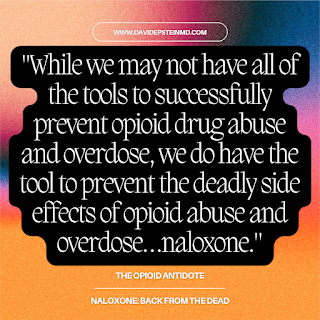We’ve been hearing about the opioid epidemic for a while and, most recently, the surge in fentanyl overdoses. Fentanyl has been particularly deadly because it is mixed with other drugs without the user's knowledge. The opioid drug class consists of a number of medications, including morphine, oxycodone, hydrocodone, methadone, heroin, fentanyl, and others. They all have similar side effects that make them deadly, but fentanyl is approximately 100 times more potent than morphine. So, a very small amount of fentanyl can have a very large effect on someone.
 Opioids are primarily used for pain control. However, they also have several side effects that need to be considered. Aside from minimizing or eliminating pain, opioids can cause drowsiness, confusion, nausea, constipation, euphoria, and slowed breathing. The side effects on the brain (drowsiness, confusion, and slowed breathing) can also be potentiated when mixed with other drugs that cause similar effects, like alcohol and benzodiazepines. Death from opioids usually occurs when the breathing slows or stops, as the user becomes more sedated and slips into unconsciousness. The resulting respiratory depression causes a lack of oxygen to enter the body and there is subsequent organ damage and death, if not reversed quickly.
Opioids are primarily used for pain control. However, they also have several side effects that need to be considered. Aside from minimizing or eliminating pain, opioids can cause drowsiness, confusion, nausea, constipation, euphoria, and slowed breathing. The side effects on the brain (drowsiness, confusion, and slowed breathing) can also be potentiated when mixed with other drugs that cause similar effects, like alcohol and benzodiazepines. Death from opioids usually occurs when the breathing slows or stops, as the user becomes more sedated and slips into unconsciousness. The resulting respiratory depression causes a lack of oxygen to enter the body and there is subsequent organ damage and death, if not reversed quickly.So, can this process be reversed? Thankfully, the answer is “yes”. The medication, naloxone or Narcan, is the antidote to opioids and blocks their effects. But, the antidote for an opioid overdose must be administered quickly before the body suffers the irreversible effects of a lack of oxygen. Once given, however, naloxone works instantly. The opioid effects are immediately reversed. While someone can be barely breathing and unconscious, the individual awakens suddenly and starts breathing immediately after the naloxone is given. It is like rising from the dead. One moment, an individual is completely unconscious and the next, they are awake and alert. It is surreal to watch.
However, the duration of the effect of naloxone is often shorter than the opioid that caused the deadly side effects. Naloxone will last about 30-90 minutes, but the opioid that is circulating in the body may last longer because of the type and amount used. It is not unusual for a person who had the effects of an opioid overdose reversed by naloxone to slip back into somnolence and unconsciousness when naloxone wears off before the opioid does. As the naloxone stops working in the body, the person can develop respiratory depression again. So, a repeat dose of naloxone needs to be given.
Some naloxone facts:
- Naloxone is Narcan (Narcan is the brand name and naloxone is the generic name).
- Naloxone can be given by nasal spray or by injection (intramuscular or intravenous).
- Naloxone is the antidote for opioids (i.e., morphine, fentanyl, heroin, etc.) and their side effects.
- Naloxone is NOT the antidote for alcohol, benzodiazepines (i.e., Valium, Ativan, etc.), or other illicit drugs.
- If someone uses opioids chronically and has physiologic dependence on them, naloxone can trigger acute opioid withdrawal symptoms which can include a fast heart rate, elevated blood pressure, fever, sweating, agitation, and other symptoms.
- Naloxone’s duration of effect can be shorter than the opioid involved in the overdose, so naloxone may need to be given multiple times until the opioid effects wear off on their own.
 Naloxone is a life-saving medication if someone is suffering from an opioid overdose and develops respiratory depression. Opioid overdose has become a problem for some kids because they may be exposed to fentanyl without their knowledge when it is mixed with other illicit drugs that have been taken. Because of the concern for opioid overdoses in children at school, the Los Angeles Unified School District (LAUSD) is providing naloxone to its schools to combat the problem. Also, the medication has been made readily available and free to those who may be at risk for opioid overdose in many US states. While we may not have all of the tools to successfully prevent opioid drug abuse and overdose, we do have the tool to prevent the deadly side effects of opioid abuse and overdose…naloxone.
Naloxone is a life-saving medication if someone is suffering from an opioid overdose and develops respiratory depression. Opioid overdose has become a problem for some kids because they may be exposed to fentanyl without their knowledge when it is mixed with other illicit drugs that have been taken. Because of the concern for opioid overdoses in children at school, the Los Angeles Unified School District (LAUSD) is providing naloxone to its schools to combat the problem. Also, the medication has been made readily available and free to those who may be at risk for opioid overdose in many US states. While we may not have all of the tools to successfully prevent opioid drug abuse and overdose, we do have the tool to prevent the deadly side effects of opioid abuse and overdose…naloxone.Have you ever seen naloxone used?




Comments
Post a Comment